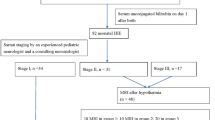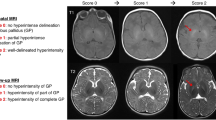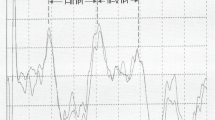Abstract
OBJECTIVE:
Apnea of prematurity (AoP) is, in part, a reflection of brainstem-mediated respiratory control system maturation. We previously demonstrated changes in brainstem function in relation to hyperbilirubinemia (bilirubin encephalopathy, (BE)) as evaluated by auditory brainstem evoked responses (ABR) in infants 28 to 32 weeks gestational age (GA). We hypothesized that in this population, as bilirubin increases and causes auditory brainstem dysfunction, respiratory control system may also be adversely affected leading to increased frequency of AoP.
STUDY DESIGN:
We studied 100, 28 to 32 weeks GA infants and identified 66 with normal and 34 with abnormal ABR progression in temporal relation to hyperbilirubinemia (BE). The abnormal ABR progression was associated with elevated bilirubin, specifically elevated unbound bilirubin levels. A blinded, retrospective chart review quantified the amount of weekly apnea and bradycardia events during the hospital stay, total duration of methylxanthine treatment, total duration of mechanical ventilation, CPAP, and/or nasal cannula, and risk factors for apnea (sepsis, IVH grade >II, asphyxia). Since mechanical ventilation confounds the identification of apnea, infants requiring mechanical ventilation were excluded from further review (n=60; 21 with BE and 39 with normal ABR progression). Data from the remaining 40 infants were analyzed. Student's t-test was used to analyze continuous variables if the distribution was normal otherwise Wilcoxon-ranked-sum test was used. χ2 was used to analyze nominal variables. A p≤0.05 was considered significant.
RESULTS:
There was no difference in risk factors between infants with and without BE. BE was identified on day 3 (median; range 1 to 6 days). Patients with BE had significantly more apneic events (15 vs 2, p=0.0009), bradycardic events (14 vs 1, p=0.02), and required more prolonged treatment with CPAP (2.2 vs 0.5 days, p=0.007), nasal cannula (6.6 vs 2.2 days, p=0.02), and methylxanthines (9.5 vs. 1.9 days, p=0.002) than those with normal ABR progression. The difference in the incidence of apnea and bradycardia between infants with and without BE was most pronounced during the first week.
CONCLUSIONS:
Premature infants with transient bilirubin encephalopathy as defined by abnormal ABR progression in relation to hyperbilirubinemia have more concurrent apneic events and require more prolonged respiratory support and medications.
This is a preview of subscription content, access via your institution
Access options
Subscribe to this journal
Receive 12 print issues and online access
$259.00 per year
only $21.58 per issue
Buy this article
- Purchase on Springer Link
- Instant access to full article PDF
Prices may be subject to local taxes which are calculated during checkout
Similar content being viewed by others
References
Amin SB, Merle KS, Orlando MS, Dalzell LE, Guillet R . Brain stem maturation in premature infants as a function of enteral feeding type. Pediatrics 2000;106 (2):318–322.
Tyson JE, Lasky R, Flood D, et al. Randomized trial of taurine supplementation for infants >1300 gram birth weight: effect of auditory brain-stem evoked responses. Pediatrics 1989;83:406–415.
Kohelet D, Arbel E, Goldberg M, Arlazzoroff A . Transient neonatal hypothyroxinemia and the auditory brain stem evoked response. Pediatr Res 1992;32:530–531.
Amin SB, Orlando MS, Dalzell LE, Merle KS, Guillet R . Brainstem maturation after antenatal steroids exposure in premature infants as evaluated by auditory brainstem-evoked response. J Perinatol 2003;23:307–311.
Moller AR, Jannetta PJ, Moller MB . Neural generators of brainstem evoked potentials: results from human intracranial recordings. Ann Otol Rhinol Laryngol 1981;90:591–596.
Starr A . Auditory brainstem potentials: comments on their use during infant development. J Clin Neurophysiol 1984;1:331–334.
Amin SB, Orlando MS, Dalzell LE, Merle KS, Guillet R . Morphological changes in serial auditory brainstem responses in 24–32 weeks' gestational age infants during the first week of life. Ear Hear 1999;20:410–418.
Wennberg RP, Ahlfors CE, Bickers R, McMurtry CA, Shetter JL . Abnormal auditory brainstem response in a newborn infant with hyperbilirubinemia: improvement with exchange transfusion. J Pediatr 1982;100 (4):624–626.
Perlman M, Fainmesser P, Sohmer H, et al. Auditory nerve-brainstem evoked responses in hyperbilirubinemic neonates. Pediatrics 1983;72:658–664.
Nakamura H, Takada S, Shimabuku R, Matsuo M, Matsuo T, Negishi H . Auditory nerve and brainstem responses in newborn infants with hyperbilirubinemia. Pediatrics 1985;75 (4):703–708.
Funato M, Tamai H, Shimada S, Nakamura H . Vigintiphobia, unbound bilirubin, and auditory brainstem responses. Pediatrics 1994;93 (1):50–53.
Lenhardt ML, McArter R, Bryant B . Effects of neonatal hyperbilirubinemia on the brainstem electric response. J Pediatr 1984;104 (2):281–284.
Amin SB, Orlando MS, Merle KS, Dalzell LE, Guillet R . Sequential changes in BAER and their relation to bilirubin levels in neonates less than 32 weeks gestational age. Pediatr Res (abstract) 1997;41 (4):135A.
Chisin R, Perlman N, Sohmer H . Cochlear and brainstem responses in hearing loss following neonatal hyperbilirubinemia. Ann Otol Rhinol Laryngol 1979;89:352–357.
De Vries LS, Lary S, Dubowitz LMS . Relationship of serum bilirubin levels to ototoxicity and deafness in high-risk low birth weight infants. Pediatrics 1985;76:351–354.
Bergman I, Hirsch RP, Fria TJ, Shapiro SM, Holzman I, Painter MJ . Causes of hearing loss in the high risk premature infant. J Pediatr 1985;106:95–101.
Amin SB, Ahlfors C, Orlando MS, Dalzell LE, Merle KS, Guillet R . Bilirubin and serial auditory brainstem responses in premature infants. Pediatrics 2001;107:664–670.
Govaert P, Lequin M, Swarte R, et al. Changes in globus pallidus with preterm kernicterus. Pediatrics 2003;112 (6 Part 1):1256–1263.
Vohr BR . New approaches to assessing the risk of hyperbilirubinemia. Clin Perinatol 1990;17 (2):293–306.
Henderson–Smart D, Pettigrew AG, Campbell DJ . Clinical apnea and brainstem neural function in preterm infants. N Eng J Med 1983;308:353–357.
Acknowledgements
We thank all the neonatal intensive care unit nurses in monitoring the infants for apnea and bradycardia events during the course of the study. We thank Dr. Lois Johnson for her guidance during the preparation of this manuscript.
Author information
Authors and Affiliations
Rights and permissions
About this article
Cite this article
Amin, S., Charafeddine, L. & Guillet, R. Transient Bilirubin Encephalopathy and Apnea of Prematurity in 28 to 32 Weeks Gestational Age Infants. J Perinatol 25, 386–390 (2005). https://doi.org/10.1038/sj.jp.7211295
Published:
Issue Date:
DOI: https://doi.org/10.1038/sj.jp.7211295
This article is cited by
-
The effect of different intravenous lipids on free bilirubin levels in premature infants
European Journal of Clinical Nutrition (2022)
-
Folic acid alleviates jaundice of phenylhydrazine (PHA)-induced neonatal rats by reducing Lys-homocysteinylation of albumin
Cell Biology and Toxicology (2021)
-
High unbound bilirubin for age: a neurotoxin with major effects on the developing brain
Pediatric Research (2019)
-
Is Neonatal Jaundice Associated with Autism Spectrum Disorders: A Systematic Review
Journal of Autism and Developmental Disorders (2011)



